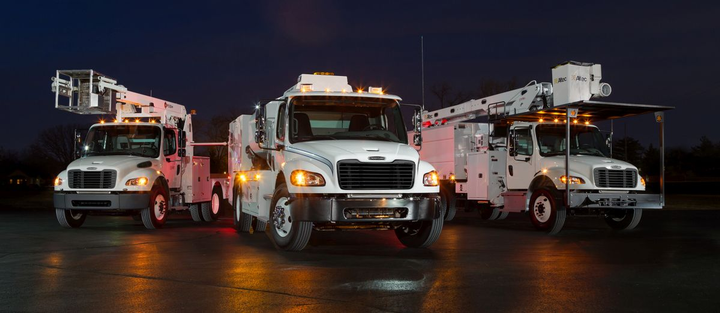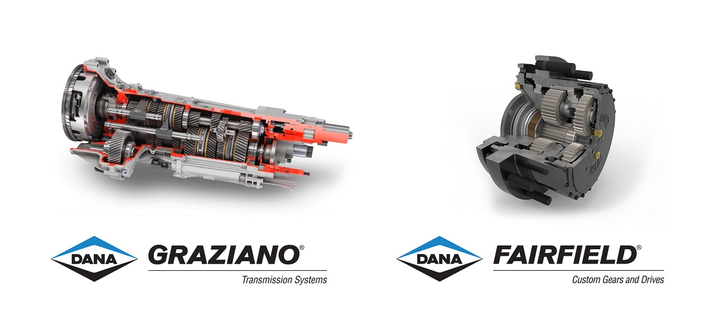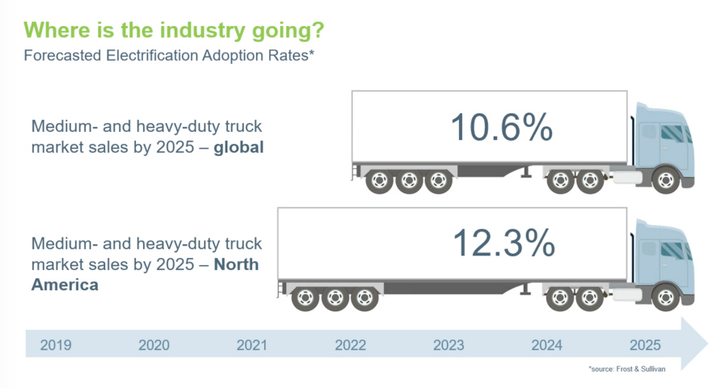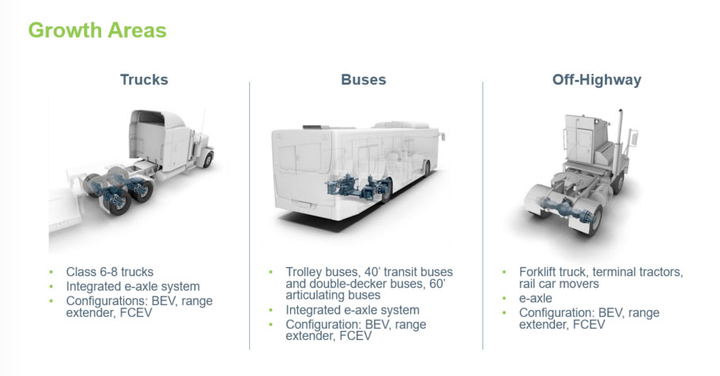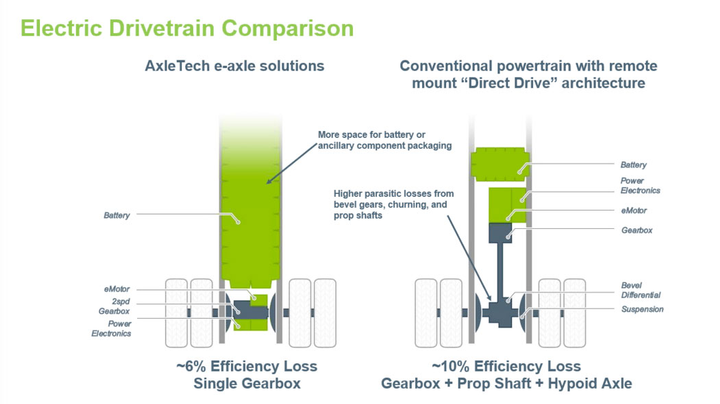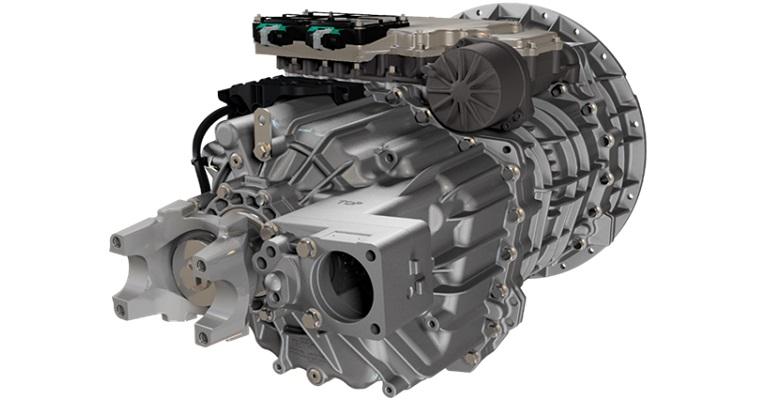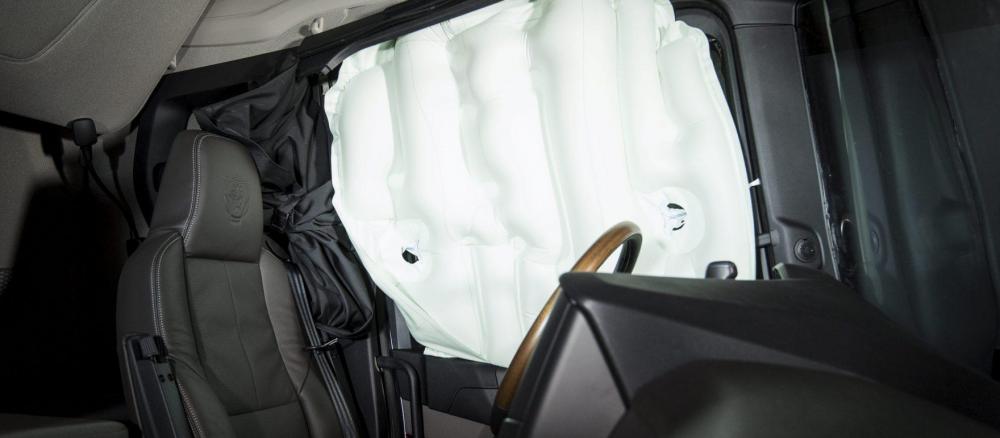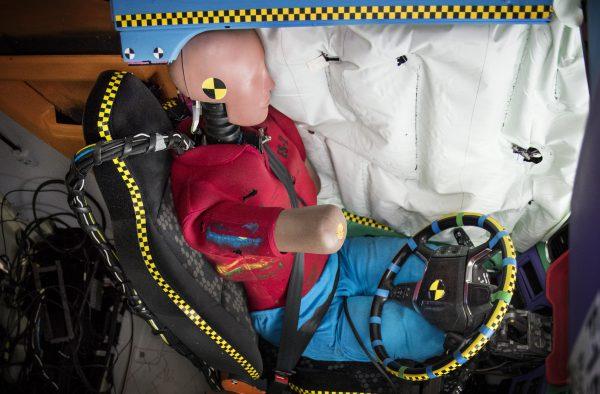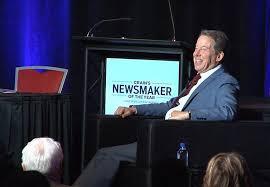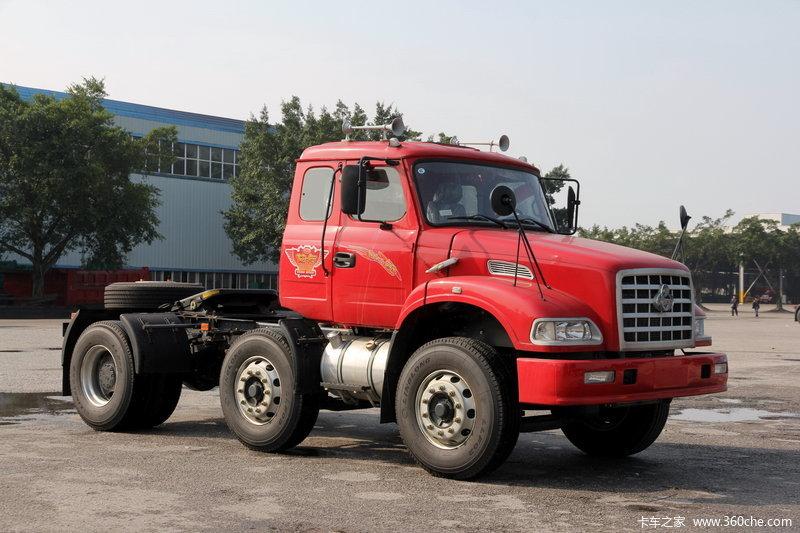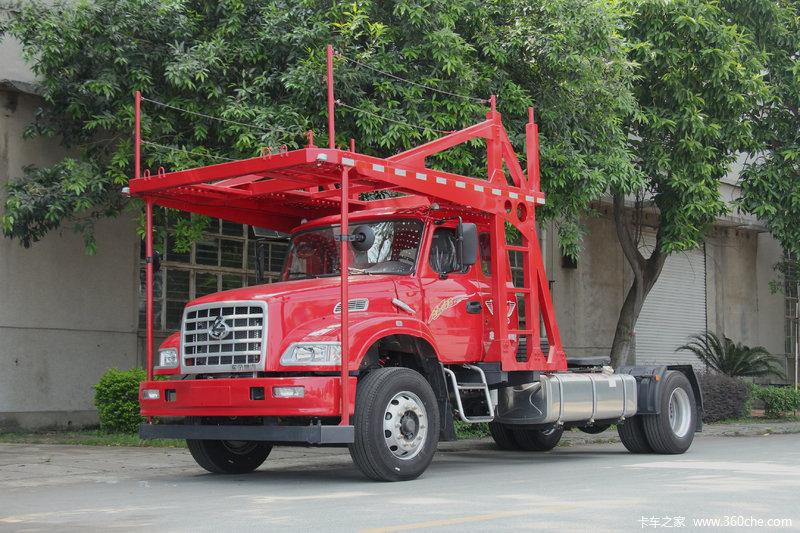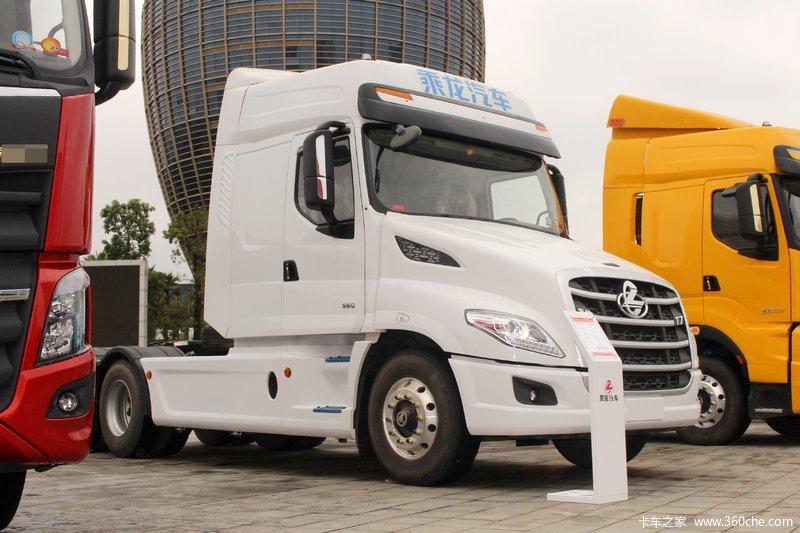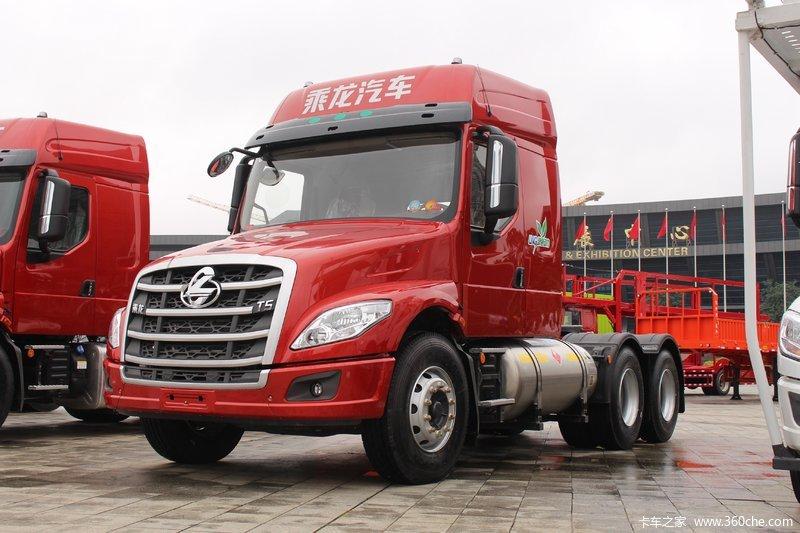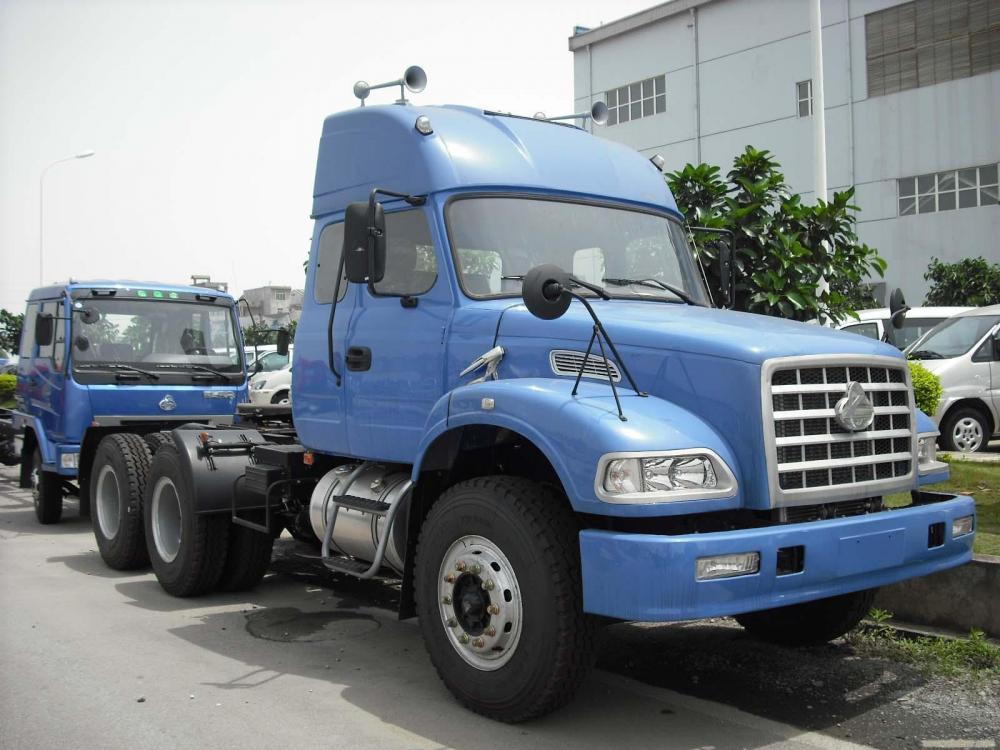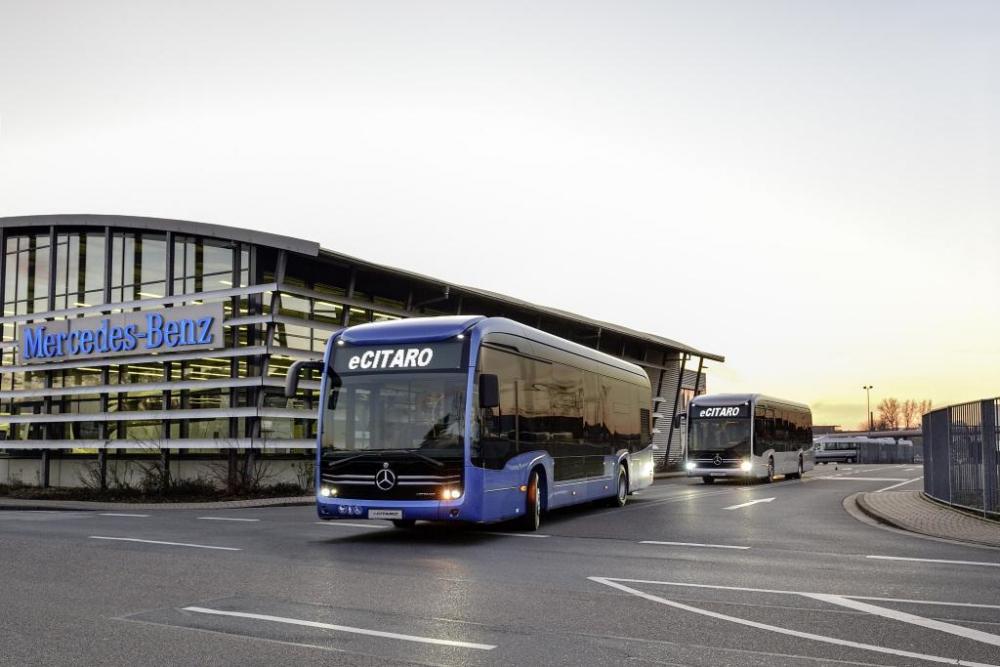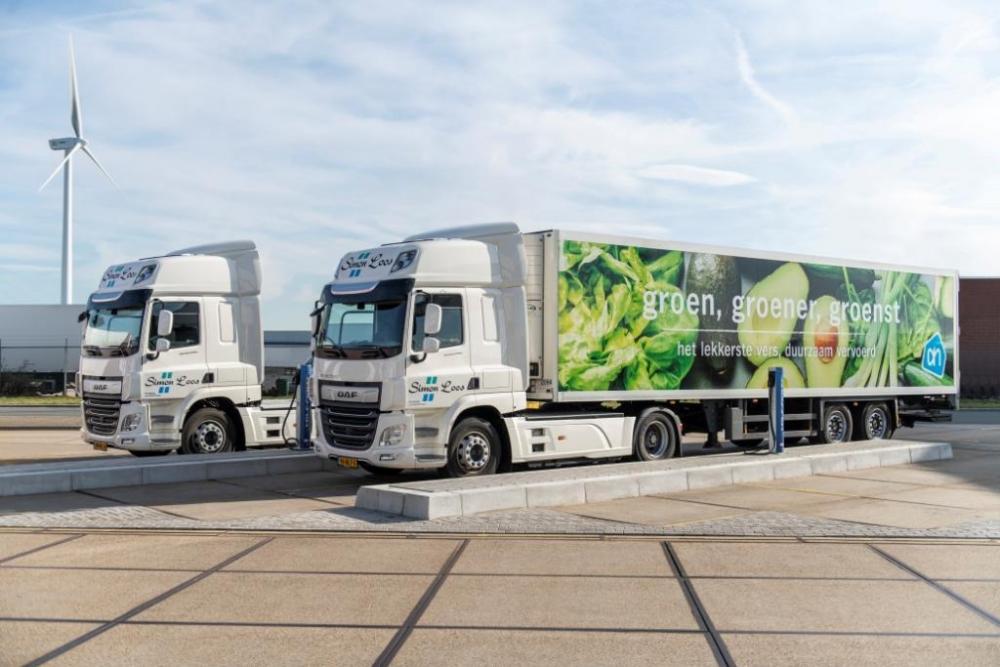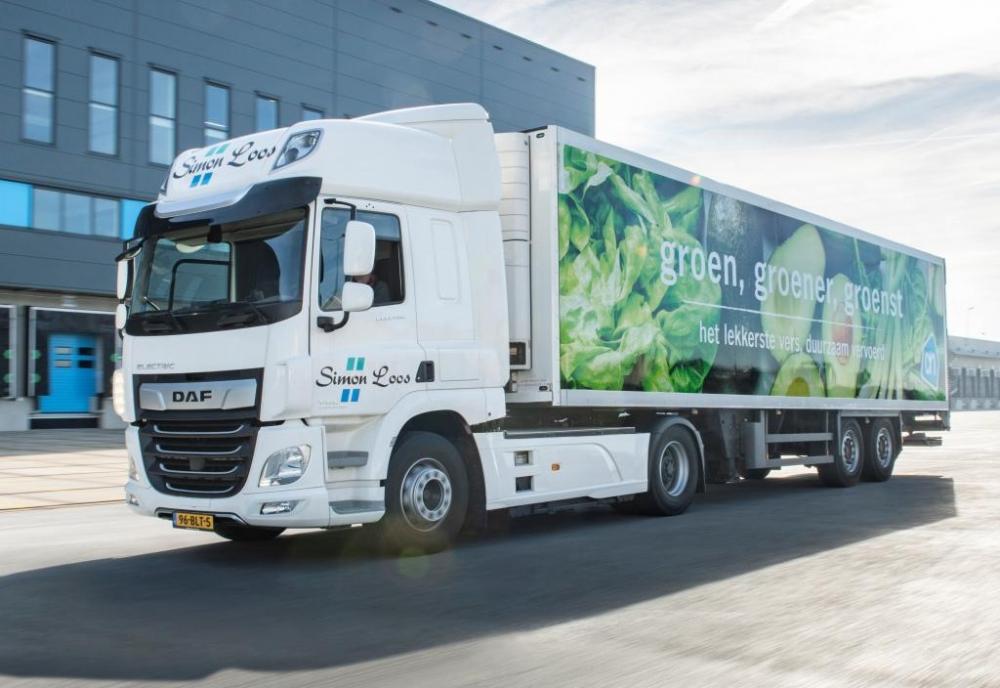
kscarbel2
Moderator-
Posts
18,905 -
Joined
-
Days Won
114
Content Type
Profiles
Forums
Gallery
Events
Blogs
BMT Wiki
Collections
Store
Everything posted by kscarbel2
-
Heavy Duty Trucking (HDT) / March 1, 2019 At The Work Truck Show 2019, Freightliner will exhibit a wide range of its vocational vehicles and powertrain options in its booth. Visitors to the booth can also explore the new battery-electric Freightliner eM2 truck. In addition to the eM2, several of Freightliner’s vocational truck models will be on display in the booth, including the Freightliner 114SD, which can now be spec’ed with the lightweight Cummins X12 engine. Other Freightliner work trucks – such as the 108SD and the M2 106 – will be upfitted with a range of bodies that demonstrate different customization options. Part of Daimler Trucks North America’s (DTNA) e-mobility initiative, the medium-duty eM2 is being designed for local distribution, pickup and delivery, and last-mile logistics applications. The first eM2 was recently delivered to Penske Truck Leasing for real-world testing as part of the Freightliner Electric Innovation Fleet, reflecting DTNA’s co-creation approach with customers to co-develop technology that shapes the future of transportation. The Innovation Fleet is developed in partnership with Penske Truck Leasing and NFI, and is partially funded by a $16 million grant from the South Coast Air Quality Management District (SCAQMD). Series production of the eM2 begins in 2021. This year, Freightliner is a Platinum sponsor of the Green Truck Summit, which focuses on clean energy trends and initiatives for commercial vehicles. Freightliner has been a sponsor of the Green Truck Summit since 2012. “DTNA is investing heavily in the development of practical and sustainable electric vehicles to support our customers and the environment,” said Kelly Gedert, director of product marketing for Freightliner and Detroit. “We are committed to providing value to our customers’ businesses in a world of constantly evolving challenges, which is why we continue to develop our product portfolio to positively impact their business needs.” Work Truck show attendees will also see the market-leading powertrain options that are ideal for vocational applications, including the Detroit DD5, Detroit DD8, and Detroit DD13 engines. .
-
-
MAN Truck & Bus Press Release / February 28, 2019 Curtain up for our new MAN CitE According to the motto “Reinventing the urban landscape” the perfect truck for urban delivery and distribution transport combines avant-garde exterior with ergonomic and safety to provide high efficiency – eMobility at its best. Find out more here: https://go.man/9jqbTXt8 ,
-
Heavy Duty Trucking (HDT) / March 1, 2019 Dana Incorporated has acquired the Drive Systems segment of the Oerlikon Group, including the Graziano and Fairfield brands. The acquisition expands the company’s capabilities in electrification and improves its manufacturing presence in key markets, according to Dana. The Drive Systems business serves a global roster of original equipment manufacturers with a portfolio of high-tech products that can be found in a wide range of applications for operating machinery and equipment used in agriculture, construction, energy, mining, on-road transportation, and high-performance sports cars. “Dana’s acquisition of the Drive Systems segment of Oerlikon enables us to support our customers’ shift toward vehicle electrification across nearly every vehicle architecture in the light vehicle, commercial vehicle, and off-highway segments,” said James Kamsickas, president and chief executive officer of Dana. “The Drive Systems business’ highly talented team is also strategically positioned to give our customers access to critical manufacturing capabilities in key growth markets, such as India, China, and the United States.” The addition of the Drive Systems segment to Dana is immediately accretive to earnings and creates a number of opportunities for increased revenue and profitable growth, including: Extending Dana’s current technology portfolio, especially in the area of high-precision helical gears for the light- and commercial-vehicle markets, as well as planetary hub drives for wheeled and tracked vehicles in the off-highway market. Growing Dana’s electronic controls capability for transmissions and drivelines through the acquisition of VOCIS, a wholly owned business of Oerlikon Drive Systems, and further expanding its motors technologies through Ashwoods Electric Motors. Increasing Dana’s product offerings that support vehicle electrification in each of Dana’s end markets – light vehicle, commercial vehicle, and off-highway. Optimizing Dana’s global manufacturing presence to be closer to customers in key growth markets such as China and India, as well as the United States. And adding four research and development facilities to Dana’s extensive network of technology centers, as well as 12 facilities to the company’s global manufacturing footprint. .
-
Deborah Lockridge, Heavy Duty Trucking (HDT) / March 1, 2019 AxleTech, which turns 100 years old this year, is reinventing itself with a focus on electrified vehicle solutions. By focusing on a “power-agnostic” between-the-wheels electrification technology, it believes it can provide integrated, in-axle systems that provide the same power and efficiency as conventional diesel powertrains – and maybe even better. “This is key, as vehicle manufacturers and owners will demand this with any powertrain change,” explained Jason Gies, AxleTech director of business development for electric vehicle systems, in a March 1 webinar for reporters. AxleTech, based in Troy, Michigan, traces its roots back 100 years as part of the original Rockwell International. Since then there have been a number of name changes and ownership transitions. Today, the company is emphasizing the “tech” in its name, providing advanced powertrain systems, axles, brakes, components, and aftermarket and remanufactured parts for heavy-duty commercial and defense applications. Key in its growth is commercial vehicle electrification. According to a Frost & Sullivan report, AxleTech said, the electrification adoption rate for medium- and heavy-duty trucks is expected to be 10.6% by 2025 globally, and 12.3% for North America. The forecast calls for growth to increase starting in 2020. “That’s just next year,” Gies said. “The industry is looking at a lot of growth very quickly.” Three years ago, AxleTech put together a team to develop electrified axle solutions. The company plans to make a big announcement at ACT Expo in April, but already has developed several electrified axle solutions. It has several vehicle partners: • Thor Trucks. AxleTech is developing an on-highway fully integrated e-axle system that it will pair with Thor’s proprietary batteries • Wrightspeed, which is making range-extended electric powertrains • Proterra, an electric bus start-up, which Daimler last year made a big investment in. Part of what AxleTech developed are two-speed gear boxes that give the Proterra system a 20% efficiency improvement. In fact, Gies said, Proterra in 2017 set a world record for longest distance traveled on a single charge, over 1,100 miles, for any vehicle. AxleTech's “between the wheel” systems are power-agnostic, Gies noted. It could be full battery electric, hydrogen fuel cells, range-extending technology, or even hybrids. “We require three essential things from the OEM: a cooling line, a control cable, and a power cable – and AxleTech does everything else.” AxleTech contends its system-engineered technology has an advantage over early electric truck solutions that involved replacing the truck engine with a single, large electric motor and multi-speed gearbox. This configuration is referred to as a “direct drive” solution, because it follows the traditional longitudinal drivetrain platform. However, AxleTech said, this approach has shortcomings, including poor packaging, efficiency, cost, and compatibility of the major components. More recent commercial EV powertrains have very specialized configurations, AxleTech says, but varying degrees of customized chassis, suspensions, and e-powertrains raise concerns of long-term supportability and cost. In contrast, Gies told reporters, AxleTech designs its technology to address four key factors: Performance, cost, maintenance support, and packaging (easily integrated into current vehicle platforms.) Next month at ACT Expo in Long Beach, California, AxleTech said, it will launch “the most efficient electric powertrain in the world for Class 6-8 trucks,” as well as a compact and powerful system for low-floor transit buses and some new strategic partnerships. .
-
Trailer-Body Builders / February 27, 2019 Eaton Cummins Automated Transmission Technologies recently expanded its Endurant automated transmission lineup to include a new dual Power Takeoff (PTO) version of the 12-speed model. The new dual PTO option of Endurant provides customers with two PTO mounting locations: an eight-bolt bottom mount and a four-bolt rear mount with a combined 95 horsepower capability. A single PTO model with an eight-bolt bottom mount location also is available, giving fleets enhanced flexibility in the secondary market. “We’re very excited to put our award-winning Endurant in the hands of more fleets,” said Charles Masters, general manager of Eaton Cummins Automated Transmission Technologies. “The dual PTO model will allow more fleets to experience the many industry-leading features of Endurant.” Since the launch of the 12-speed overdrive model in late 2017, the Endurant portfolio has expanded to include an 11-speed direct-drive model with calibrations optimized to meet the needs of linehaul and regional fleets typically operating at lower cruise speeds and on flatter terrain. Having overdrive and direct-drive models gives fleet managers the choice to select the best ratio for their application and route, the company said. All Endurant transmissions have a variety of features designed to reduce maintenance and increase uptime: Internal electrical system routing that minimizes exposure and corrosion to wires and connectors for improved reliability; A smart prognostics feature provides clutch replacement notification to better plan maintenance scheduling; An industry-exclusive transmission fluid pressure sensor notifies drivers of low oil levels to provide burn-up warranty coverage; Smooth and intuitive shift strategies that enhance the operator’s driving experience; Predictive shifting using look-ahead technology to execute shift decisions that improve fuel efficiency and provide additional driver comfort; A maintenance-free 430-millimeter self-adjust clutch that requires no grease; An industry-leading 750,000-mile lube change interval in linehaul applications; Endurant requires only 16 pints of lubricant, about half the amount of competitive models; A replaceable input shaft sleeve allows for affordable and quick repair, while competitive transmissions require a costly and time-consuming full teardown; and, Capable of maximum 510 horsepower and 1,850 foot-pounds of torque. Like all automated transmissions from the Eaton Cummins joint venture, Endurant is available with IntelliConnect, a telematics capable system designed to provide near real-time monitoring of vehicle fault codes, prioritizes critical events and provides accurate and comprehensive action plans by technical experts at Eaton. The primary objective of IntelliConnect is to increase a fleet’s uptime by reducing unplanned downtime and providing quicker repair diagnostics through remote communication with a vehicle’s transmission. The joint venture’s components are backed by Eaton’s Roadranger network of more than 180 drivetrain professionals who provide solutions, support and expertise to fleets and dealers. For more information visit eaton.com/roadranger, where the latest product information is available, as well as service, parts and training assistance. To learn more about Endurant, please visit eatoncumminsjv.com/endurant. .
-
https://getransportation.com/wabtec-and-ge-transportation-merge-creating-global-leader-rail-equipment-services-and-software http://old.post-gazette.com/businessnews/19990604motive2.asp
-
Automotive News - Reuters / February 27, 2019 FRANKFURT -- German auto supplier ZF Friedrichshafen AG is considering a takeover of Belgium-based competitor Wabco and the two companies have held preliminary discussions. ZF Friedrichshafen's supervisory board has already discussed a potential acquisition of Wabco, a German newspaper paper reported, citing financial sources, adding that no decision had been taken. Wabco Holdings Inc. shares, which carry a market value of about $6.2 billion, rose 8 percent to close the day at $130.49. Wabco issued this statement following earlier reports: "In response to market speculation and noting recent appreciation in its stock price, the company confirmed today that it has been approached by ZF Friedrichshafen AG and has engaged in preliminary discussions concerning a potential transaction." The company, based in Brussels, specializes in braking control systems and other safety technologies for commercial vehicles. Last week Wabco reported record annual sales and earnings, posting net income of $418 million on revenue of $3.83 billion. It employs about 15,000 people in 40 countries. "ZF regularly reviews strategic options for action, including acquisitions, but there is no decision in this direction," a ZF spokesman told Reuters. ZF has done large acquisitions in the past and in 2014 bought TRW Automotive for $13.5 billion to expand into the potentially lucrative self-driving car market. In June, ZF CEO Wolf-Henning Scheider, when asked if Wabco could still be of interest, said that brakes were not a priority for ZF at the moment as it focuses on the switch to electric and autonomous driving. ZF plans to invest more than 12 billion euros ($13.6 billion) into e-mobility and autonomous driving. ZF ranks No. 5 on the Automotive News list of the top 100 global suppliers with worldwide sales to automakers of $34.5 billion in 2017.
-
Kenworth Truck Co. Press Release / February 26, 2019 KIRKLAND, Washington - Kenworth Truck Company will showcase its medium and heavy duty work trucks at The Work Truck Show March 5-8 in Indianapolis, Indiana. Kenworth will also offer up the latest information and spec’ing options for its vocational truck lineup in its booth (Number 1401). The show is sponsored by the National Truck Equipment Association (NTEA). “Kenworth has long been a proud participant in The Work Truck Show. It allows us to showcase what we consider is the industry’s most complete line of trucks that can be customized to meet the requirements of our vocational customers,” said Kurt Swihart, Kenworth marketing director. “We continue to bring new products and options to market, which can help improve productivity while lowering operating costs.” The Kenworth lineup is led by the Kenworth T370 6x6 Valew Water Tanker, equipped with a 20K front drive axle and a PACCAR PX-9 engine, and a Kenworth T880 BMC Flatbed powered with a PACCAR MX-13 engine, matched to a PACCAR 12-speed automated transmission. It features the PACCAR 20K front axle. In addition, there are two more Kenworth T370s – one equipped with a Summit service body, powered with a PACCAR PX-9 engine, and one with Altec Aerial equipment, powered with a PACCAR PX-7 engine. Completing the lineup are a Kenworth T270 equipped with Vactor Paradigm body and a PACCAR PX-9 engine, and a Kenworth K370 cabover with a DuraPatcher body and a PACCAR PX-7 engine. Kenworth will offer a “Kenworth Chassis Update” from 8 a.m. to 9:15 a.m. in the Wabash 3 room on Wednesday, March 6. The informative product session will provide insights into Kenworth’s vocation-specific options that help optimize body and equipment installation and designs.
-
Scania Group Press Release / February 27, 2019 Scania’s rollover side curtain airbags targets one of the most critical consequences of rollover accidents, where drivers or passengers are injured in a collision or fatally crushed by their own vehicle. This unique solution deploy and protect those travelling in the cab if the truck rolls over. Scania’s new truck generation can be equipped with rollover side curtain airbags integrated into the headliner moulding above the doors to provide significantly-enhanced protection for those travelling in the vehicle in the event of a rollover, which is one of the most serious types of truck accidents. “Our rollover side curtain airbag ensures that the driver and any passengers on board will have a much better chance of surviving a rollover accident.” “Our rollover side curtain airbag – particularly when combined with the steering wheel airbag and our seat belt pretensioners – ensures that the driver and any passengers on board will have a much better chance of surviving a rollover accident in one of the new generation of Scania trucks, with far less severe consequences than would be the case in any other truck ,” says Christofer Karlsson, who was responsible for the development of Scania’s crash safety system. How side curtain airbags work A common reason for trucks rolling over is that the driver is forced to carry out evasive action to avoid an oncoming vehicle or an obstruction. If the truck then ends up off the road, there is rarely sufficient load-bearing capacity, so the vehicle may topple onto its side or even roll over at higher speeds. Advanced systems with sensors determine when and if the rollover side curtain airbags and any other airbags should be deployed; and when deployed, the airbags inflate instantaneously. Read more about Scania’s side curtain airbags here Want to know more about safety? Read more about Scania´s new connected C-me vest that enhances driver safety here .
-
Renault Trucks Press Release / February 25, 2019 Since 3 months, the Saint-Priest axles plant is using a drone to perform stock control in the racks, in order to improve the ergonomics and safety conditions of this operation, which was up until now long and managed using binoculars. Welcome to the industry 4.0! .
-
Daimler Press Release / February 27, 2019 Daimler Buses division in 2018: clear increase in sales and market leadership asserted in core markets, continued growth in new markets. Daimler Buses expects marked sales growth in 2019 and is aiming for a Return on Sales of 5 to 7 percent. Clear strategy with three pillars: global market presence, technology leadership and business excellence. Targeted use of partnerships worldwide, cooperation with software provider IVU. Market launch of fully electric Mercedes-Benz eCitaro and comprehensive, holistic approach for eMobility consulting in environmentally-friendly public transport. Till Oberwörder: "At Daimler Buses, we're very pleased with the 2018 business year. We've significantly increased our worldwide revenues. This shows that, thanks to the Mercedes-Benz, Setra and BharatBenz brands as well as related services, we are very well positioned in our business. We have also set some ambitious targets for ourselves for the coming year. To that end we have three strategic operating fields clearly in our focus: our global market presence, our role as a technology leader and business excellence. We will continue to offer the best comprehensive solutions to our customers in the future as the leading provider around the globe – with the best vehicles and the best package of services, consulting and mobility solutions." Stuttgart – In 2018 Daimler Buses enjoyed major sales growth, selling 30,900 buses and chassis worldwide (compared with 28,700 in the prior year). The sustained high demand for complete buses, the slowly recovering Brazilian economy and growth in India were major contributors to this great sales success. The Daimler Buses division was thus able to maintain its position as market leader in the most important core markets EU30 (EU, Switzerland and Norway), Brazil, Argentina and Mexico. Return on sales was 5.9 percent (compared with 6.2 percent in the prior year) and was therefore in line with targets. Based on the continued favourable market conditions, Daimler Buses expects a major sales increase in 2019. In Europe and India in particular, the Buses division anticipates positive sales development. For the current business year the business unit is aiming for a Return on Sales between 5 and 7 percent. Till Oberwörder, Head of Daimler Buses & Chairman of the Board of Management at EvoBus GmbH: "At Daimler Buses we're very pleased with the 2018 business year. We've significantly increased our worldwide sales. With the market launch of our fully electric Mercedes-Benz eCitaro, new digital services and our new-generation minibus, we have also taken some important steps toward the future. It was an incredible performance by our international bus team! We have also set some ambitious targets for the coming year and intend to continue growing – not just in our established markets but especially in the world's new growth regions." Clear orientation toward three strategic operating fields In order to achieve its aims Daimler Buses is concentrating on three strategic operating fields: global market presence, technology leadership and business excellence. With the help of strategic partnerships the business unit aims to ensure the generation of additional expertise in new technologies and services. Oberwörder continued: "It is our aim to be the world's leading provider of buses and mobility services. To do so we are pursuing a strategy with three clear operating fields: our global market presence, our role as a technology leader and business excellence. In the future we will continue to offer the best comprehensive solutions to our customers as the leading provider around the globe – with the best vehicles and the best package of services, consulting and mobility solutions." Global market presence: development of the core business and growth strategy for conquering new markets As a market leader in our major core markets, Daimler Buses continuously develops its classic product portfolio and thus strengthens what has traditionally been our core business. The new Mercedes-Benz Sprinter, for example, forms the basis for a completely new generation of our successful Mercedes-Benz minibuses. With products perfectly adapted to meet local requirements, an efficient production network and customer-oriented sales and service offerings, Daimler Buses continues to tap into growth potential in promising markets like North Africa, the Near and Middle East, south-east Asia and India. The Buses division benefits from the Regional Centres it established in 2015 that are located in close proximity to customers in these regions: In 2018 Daimler Buses was able to increase sales in these emerging regions by around 37 percent to nearly 7,000 units. With the Chennai plant (India) as its base, the business unit intends to gain greater market share in India with its BharatBenz brand while, at the same time, strengthening the plant as an export hub. An efficient production network ensures the Bus division remains flexible in deciding whether new export markets should be served from India, Brazil or Europe. Technology leadership: successful market launch of the fully electric Mercedes-Benz eCitaro and continued development of technology leadership With the launch last year of the fully electric Mercedes-Benz eCitaro, Daimler Buses has been able to offer a locally emission-free urban bus for environmentally-friendly public transport in cities and urban areas. The battery-electric eCitaro is series-ready. As of a few weeks ago the first vehicles are already in service as part of the public transport systems in Hamburg and Heidelberg. The bus plant in Mannheim is ready to begin deliveries. As the development of battery technology is progressing at a rapid pace, the eCitaro is already designed to be transitioned to the battery technology of the future. As of 2020 the future use of solid-state batteries will be an option. The next generation of our lithium-ion batteries will soon follow. Furthermore, as of 2022 the eCitaro’s range will be increased yet again by a range extender in the form of a fuel cell for generating electricity. The fully electric eCitaro is also part of the complete eMobility system of Daimler Buses, which advises customers on the range of applications. A customised service concept is part of the portfolio. In the coming months Daimler Buses will be expanding this portfolio and has a five-percent share in IVU -- one of the leading companies in the creation of business management software for public transport operations. As part of this strategic partnership, Daimler Buses and IVU are working together on the close integration of eCitaro into the operational management of businesses. Thanks to this cooperation with IVU, software solutions can be developed for transport companies that can be implemented in existing systems in a practical manner. An important milestone on the road to connecting vehicles is the digital Portal Omniplus On. All of the existing and new digital services for buses are bundled here. One of the new services launched in 2018 included Omniplus Uptime, which optimizes bus workshop visits and helps avoid downtime. Additional digital services such as Omniplus On monitor (provides the fleet manager with real-time data on the vehicle and driver) and Omniplus On commerce (online shop for spare parts in Europe) are waiting in the starting blocks. Business excellence for sustainable, profitable growth In order to create the basis for sustainable, profitable growth, Daimler Buses is continuously developing its worldwide production network. To this end the Buses division bundles its competence in development and production such as, for example, the safety technologies and assistance systems at the Neu-Ulm location and the series production of electric buses in the Mannheim plant. As announced in 2017, by 2020 about 140 million euros will be invested in production locations and about 200 million euros in new technologies. Strategic cooperation with partners as a success factor In addition to the systematic cooperation with other Daimler business units, in the future Daimler Buses will increasingly count on strategic collaboration with partners. This should generate new perspectives and additional expertise in technologies and services. Collaboration will allow the Buses division to tailor its products even more closely to the needs of new markets and customers and, in turn, launch innovation to the market more quickly. .
-
MAN Truck & Bus Press Release / February 26, 2019 Tailor-made solutions simply from a single source. We build your vehicle according to your wishes. Your drivers and passengers will be thrilled. .
-
I suggest you go back with Mack "body bound" bolts, reaming new holes accordingly, 0.652 (5/8" BB bolts) or 0.776 (3/4" BB bolts). From page 30...............https://www.macktrucks.com/-/media/files/body-builder/manuals/7-frame.pdf/
-
From 1955 to 1973, Mr. Sztykiel held several engineering positions from Project Engineer of Dodge Truck Operations, Chrysler Corporation, to Assistant Chief Engineer Heavy Trucks, Chrysler Corporation. From 1973 to 1975, he served at Diamond Reo Trucks, Inc., where he first held the position of Vice-President of Engineering and subsequently, Vice-President of Sales. Mr. George Sztykiel was Spartan’s founder, becoming CEO in December 1992. He served as President and Director of Spartan from its incorporation in September 1975. He retired from Spartan in 2014. Born in 1929 in Poland, Mr. Sztykiel holds a B.S. degree in Mechanical Engineering from the University of London, England.
-
Bill Ford: Mustang-inspired electric crossover 'going to go like hell' Michael Martinez, Automotive News / February 25, 2019 When Ford Motor Co. was attempting to dethrone Ferrari on the racetrack at Le Mans, then-President Henry Ford II had one directive for his drivers: "Go like hell." More than a half-century later, Hank the Deuce's nephew called on that phrase to help define the company's first battery-electric crossover, due out next year. Speaking Monday at the Crain's Detroit Business Newsmaker of the Year luncheon, Ford Executive Chairman Bill Ford said the Mustang-inspired vehicle "is going to go like hell." The callback to that phrase isn't an accident. It underscores a change in strategy for how Ford views its EVs. The company's early forays into electrification included now-discontinued vehicles such as the Focus Electric and C-Max plug-in hybrid that were known more for their fuel economy than performance capabilities. "When we first started talking about electrification, there was this thought that there had to be a trade-off: It was either going to be green and boring and no fun, or really exciting but burn a lot of fossil fuels," Ford said. "Electrification has come to the point that you can do both." The vehicle will have a range of more than 300 miles. Production was originally slated for Flat Rock, Mich., near Detroit, but Ford last year decided instead to build the vehicle in Mexico. Ford has created a dedicated business unit, dubbed Team Edison, to handle production of its EVs. The team is based in Corktown, a Detroit neighborhood where the automaker is spending roughly $740 million to rehab an old train station. The station, abandoned for decades, will become the centerpiece of a new campus the company will use to woo young talent. The renovation is expected to take four years. Ford said Monday he'd like to fill the building with a mix of suppliers, software developers, tech startups and — potentially — other automakers. Ford last month announced the beginning of a global alliance with Volkswagen Group that will include collaborating on pickups and commercial vans. The two sides are also discussing electric and autonomous vehicle development. Ford said VW, in theory, could lease space in the building. "It could be them," he said. "Anybody who wants to come down and be part of this ecosystem, we'd love it." .
-
mack medium duty trucks
kscarbel2 replied to jettertrucks's topic in Modern Mack Truck General Discussion
Korea will remain a COE market, and I expect Vietnam to as well. The Chinese government wants to offer another choice, and one reason is government-owned (SOE) Dongfeng Liuzhou (in southern Guangxi Province) has been an ongoing proponent of conventional cab design while the Dongfeng* EQ140 and Jiefang CA141 were discontinued. With the change in regulations, compensating for a conventional's longer wheelbase, a 6x4 conventional can now gross 49 metric tons alike a 6x4 COE. * Dongfeng Liuzhou and Dongfeng in Hubei Province are two competing truckmakers. Volvo has a thus far unsuccessful JV with the latter. . -
Is Volvo Good Or Bad For Mack Trucks?
kscarbel2 replied to Barry's topic in Modern Mack Truck General Discussion
America was built on the back of the Mack truck, as well as the International. The legendary Loadstar was the backbone of the American farmer, carried children to and from school, and allowed states and municipalities to maintain our roads. The stunning Transtar 4070A and Transtar II 4070B were industry benchmarks in the COE segment. A young Zenon C.R. Hansen joined International Harvester in 1927. So impressed were they that the company placed him in its management training program. At age 19, with two years service, Hansen was sent to work internationally in Europe. Over the following seven years, spent on the continent and in Africa, Zenon acquired invaluable on-the-job training and learned to fluently speak French, German and Italian. Given the opportunity to go out on his own and to establish a Diamond T dealership in Portland, Oregon, Zenon reluctantly left International Harvester after 17 years. He quickly became Diamond T's largest distributor. -
Is Volvo Good Or Bad For Mack Trucks?
kscarbel2 replied to Barry's topic in Modern Mack Truck General Discussion
Exactly. America's iconic Mack Trucks, today, is nothing more than a memory......and a Volvo product wearing a Mack nameplate. "What Volvo has done, reduce an American icon down to a mere shell of its former self, should be a crime." -
mack medium duty trucks
kscarbel2 replied to jettertrucks's topic in Modern Mack Truck General Discussion
Bob and I agree 150% with you, that Ford should create a purpose-designed medium truck cab. The cost of designing such a cab, today with the use of software, is ridiculously inexpensive. Realistically......light, medium and heavy each have their own unique cab requirements. -
Mercedes-Benz eCitaro "electrifies" European transport operators
kscarbel2 replied to kscarbel2's topic in Trucking News
The only American bus manufacturer left that I can think of is California-based Gillig, and their product appears to be a generation behind. https://www.gillig.com/buses https://www.bus.man.eu/de/en/city-buses/model-overview/Model-overview.html -
Daimler Press Release / February 25, 2019 Mercedes-Benz eCitaro proves itself in daily operation in Germany Transport operators in Europe test the eCitaro's suitability for daily use Highly developed technology as the basis for maximum efficiency Stuttgart / Mannheim – The first battery-electric driven series-production Mercedes-Benz eCitaro buses have been in operation in public transport in Hamburg and Heidelberg for several weeks now. More electric buses are to follow in Germany in the coming weeks. We have now received the first orders from neighbouring European countries. At Daimler Buses, production of the eCitaro is at series level and the bus plant in Mannheim can deliver. All in all, there is not yet a universal demand for electric buses from the public transport companies. This might be because switching a conventional bus fleet to electric drive and ensuring the necessary infrastructure can be more complex than planned. Transport operators in Europe test the eCitaro's suitability for daily use At the same time as the deliveries in Germany, in a few days several eCitaro buses will be driving to locations and contract partners of Daimler Buses in Luxembourg, France and Poland. Once there, they will be integrated into local bus operations to convince those responsible for local public transport of their qualities and suitability for everyday use. The advantages of electric buses: They do not emit pollutants locally and make almost no noise. These are aspects which are currently of great importance to the development of clean air planning in many cities and regions. On the other hand it requires a lot of time and money for transport operators to change to electric buses and the necessary infrastructure. The technology of an electric bus alone is very expensive and the infrastructure must be designed to fit the local situation and requirements, for example charging stations, workshop equipment, qualification of personnel etc. Therefore Daimler Buses - one of the most experienced and strongest partners of bus operators - supports transport operators with its eMobility Consulting and Omniplus by offering individual advice, services and training to companies making the change. One of the most important stipulations necessary to Daimler Buses entering the market for electric buses was to be able to offer a vehicle which satisfies transport operators in every way just like the well-established Citaro has done a thousand times over. The electric bus must combine operating safety, availability in the daily routine and the driving safety of a series-production vehicle with the new requirements for emissions. Highly developed technology as the basis for maximum efficiency The Mercedes-Benz eCitaro is not produced in a prototype workshop but on the same production line as all of the other city buses in the plant in Mannheim and has thus achieved production standard. The distinction lies first and foremost in the drive technology. The eCitaro buses that will be available for testing in European cities are equipped with ten battery packages and a total capacity of 243 kWh as well as electric motors mounted close to the wheel hubs. The thermal management optimised to the very last detail with battery cooling, air conditioning with a heat pump and connected components is a highlight in the world of bus construction. These features ensure minimum energy consumption and in turn the highest efficiency and maximum range. The fact that the power consumption of an electric bus for heating and cooling can be as much as 50 percent is a challenge that in the main only bus specialists are aware of. The complex chassis of electric buses is characterised by the Electronic Stability Program (ESP) as well as roll and pitch control, for example. Safety, efficiency and environmental conservation are all integral to the Mercedes-Benz eCitaro. .
-
DAF Trucks Press Release / February 19, 2019 DAF Trucks helps Dutch supermarket chain Albert Heijn to supply its shops electrically. It has handed over the first electric trucks to Albert Heijn carriers Simon Loos and Peter Appel Transport. It is the start of a long-term field test involving three fully electric trucks and two plug-in hybrid trucks — with the latter marking a first in Europe. In 2014, Albert Heijn – with over 1,000 supermarkets in Holland, Belgium and Germany – signed up to the ‘Green Deal for Zero Emission City Logistics’; an initiative that brings together shippers, carriers, technicians and authorities to jointly conduct research into how to achieve maximum progress towards zero-emission deliveries in urban areas by 2025. For Albert Heijn, DAF, Simon Loos, Peter Appel Transport and TNO – Netherlands Organisation for Applied Scientific Research – the trial now launched will provide insight into how the transition to zero-emission deliveries could take shape. The best of both worlds The test project involves three battery-powered electric trucks (DAF CF Electric) and two plug-in-hybrid trucks (DAF CF Hybrid), plus a quick-charging infrastructure from VDL. The CF Electric has a fully electric range of some 100 kilometres. The CF Hybrid featuring E-Power Technology from VDL offers the best of both worlds: fully electric driving in urban areas (range: up to 50 kilometres) and efficient and clean driving in extra-urban areas thanks to the latest diesel technology from DAF. Analysis The partners intend to gather as much information as possible about the technical, operational, financial and organisational aspects involved in making zero-emission deliveries to supermarkets. TNO will analyse the results of the trial with a view to establishing a strategy for implementing zero-emission deliveries to supermarkets in the near future. Zero-emission deliveries Testing with the fully electric CF Electric trucks will initially be limited to journeys between the distribution center in Zaandam and the supermarkets in Amsterdam. With plug-in hybrid trucks, Albert Heijn can also supply stores further away from Zaandam without any emissions. The truck batteries will be charged between journeys at a specially designed charging park at the Albert Heijn distribution centre in Zaandam. .
BigMackTrucks.com
BigMackTrucks.com is a support forum for antique, classic and modern Mack Trucks! The forum is owned and maintained by Watt's Truck Center, Inc. an independent, full service Mack dealer. The forums are not affiliated with Mack Trucks, Inc.
Our Vendors and Advertisers
Thank you for your support!


